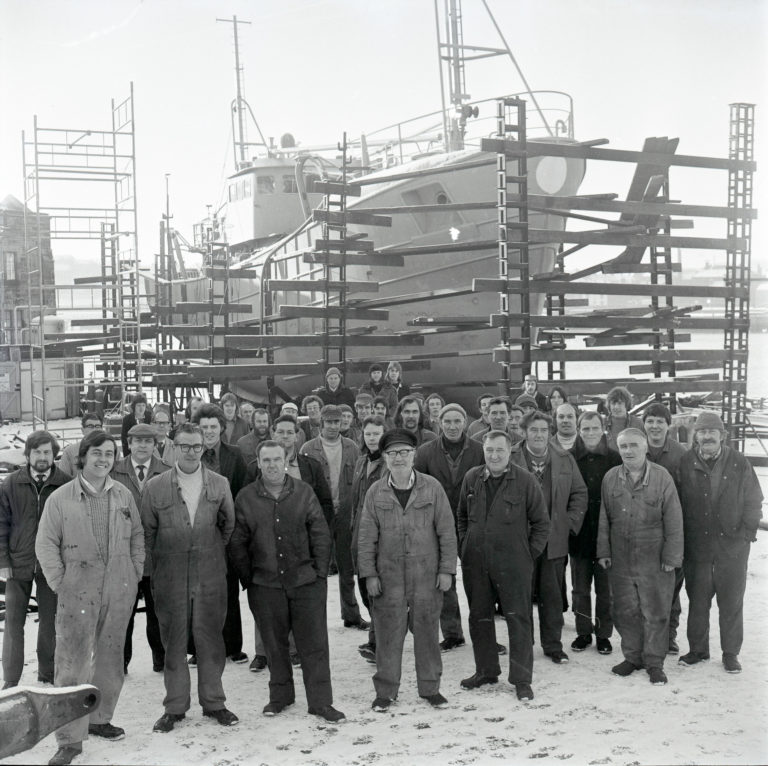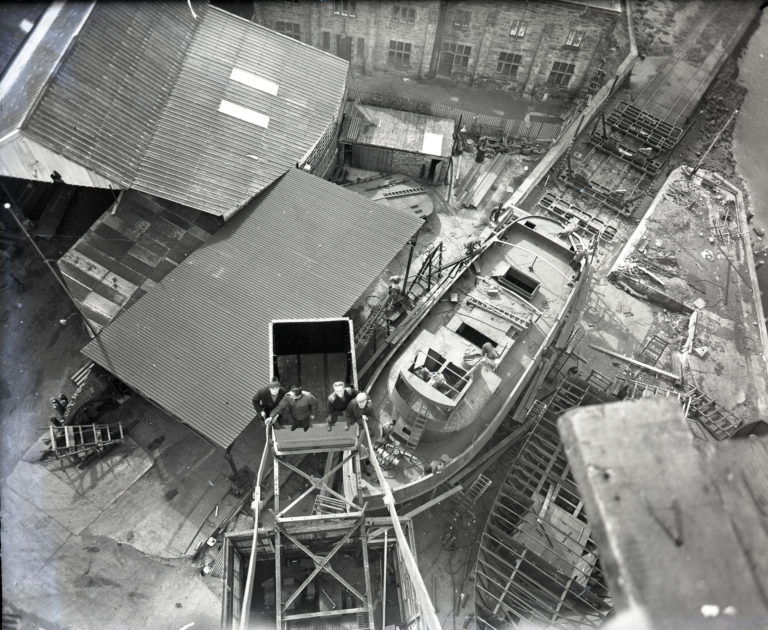Photographs of Ship Building, 1960 – 1970
Reference :BRO 1944/1/6773/21, BRO 1944/1/5126/22, BRO 1944/1/2828/11, BRO 1944/1/4012/4
Suggested age groups: KS2, KS3, KS4, Lifelong Learners
Topic areas: Environmental Portraiture, Ship Building
CONTEXT
Originally founded in 1951 as the Photo-News Service, the Photo Centre in Berwick was a staple of town life for over 65 years as a family-run press agency and photo studio.
Their premises at 17 Bridge Street had a well-equipped studio above the shop where commercial photography took place. The business also covered newsworthy events in the area and recorded family occasions and celebrations, marking milestones in the lives of several generations of townspeople.
The first photograph (BRO 1944 1/6773/21) taken in February 1970 shows the staff of Berwick Shipyard standing in front of the soon to be completed vessel ‘Lorenzo’. The shipyard operated on the Quayside until April 1979 and the men had to work in all weathers as seen here.
The second photograph (BRO 1944/1/4012/4) shows an aerial view of Berwick Shipyard taken from the top of a 90-foot crane in April 1964. Below it, two vessels can be seen under construction. None of these buildings are visible today. At this time the shipyard was owned by Fairmiles.
The third photograph (BRO 1944/1/5126/22) was taken in October 1968 during a visit of Lord Lambton, MP for the Berwick-upon-Tweed constituency from 1951-1973 to the Berwick Shipyard. 1968-1972 was one of the busiest and most productive periods in the shipyard’s history. Many of its orders were for overseas including river tugs for India.
The final photograph (BRO 1944/1/2828/11) was taken in June 1960. It shows Kylon III on the slipway at Berwick Shipyard undergoing a refit. The boat had been purchased by the River Tweed Commission to monitor salmon fishing between Berwick and Goswick. It began life as a launch on Adolf Hitler’s private yacht the Grille, before being sold after World War 2.
Shipbuilding was established in Berwick in the mid 19th century by Arthur Bryram. This business continued until 1878 but changed its name to Gowans in the late 18th century when it passed on Arthur’s death to his son in law, Robert Gowans. The yard built wooden vessels but experimented with iron hulls vessels shortly before its closure in 1878. At this time, the shipbuilding industry was declining because of quicker journey times by rail for both passengers and freight within the British Isles.
No further boats were built on the Berwick side of the River Tweed until 1950 when William Weatherhead and Sons of Cockenzie decided to open a shipyard in Berwick. There were family connections with the area. Weatherheads built barges and tugs, but their success was short lived and in 1953, the business was sold to Fairmile Construction Company Ltd. They built barges, fishing boats and tugs, constructing 21 fishing vessels between 1957 and 1961. Shipbuilding continued until 1972 when Fairmile closed because of an empty order book. However, shipbuilding was resurrected again in 1973 by Intepid Marine Ltd who again could not keep it going. They closed in 1974 and the final company to work from the shipyard area was Berwick Tweed Shipyard. Their last order was completed in 1979 with the launching of the yacht, Au Dela. After that, the business closed, and shipbuilding ceased on the Berwick side of the Tweed.
In the 1950s and 1960s over 100 men were employed at Berwick Shipyard. Ships were either launched from the slipway but were also known to have been launched directly off the side of the Quayside into the River. Unlike larger concerns, all the construction work was done outside, with no cover to protect the men in bad weather. In 1972, a planning application was made to construct a large shed on the Quayside to undertake this work undercover but it was rejected as it would have changed the view of the historic town and walls from the south bank of the Tweed. This helped to accelerate the demise of this industry in Berwick.
Today there are no visible signs of Berwick’s shipbuilding industry on Berwick Quay. It must have been a noisy industrial site but now it is a place for people to walk, set off on a boat trip on the River Tweed or enjoy a cup of coffee.
An environmental portrait is a photograph of someone in their usual environment, for example at home, in their workplace, or in an area that typically shows as aspect of the subject’s everyday life. The essence of environmental portraiture is to capture the subject in the context of their surroundings. The surroundings or background of the portrait is a key element as this is used to give further information about the person being photographed. The subject is often shown undertaking their usual tasks, such as doing an element of their job.
ARTISTS BANK
August Sander
Described as “the most important German portrait photographer of the early twentieth century”, August Sander spent his life documenting his fellow countrymen in straightforward, dignified portraits picturing farmers, merchants, civil servants, intellectuals, gypsies, and the insane so that they could be seen.
Example environmental portraiture images: Berlin Coal Carrier, 1929; Young Farmer, 1912-13; Farmer Working in the Fields, c.1930
Arnold Newman
Newman was credited with popularising environmental portraiture, a style that captures subjects in their surroundings and uses significant details to communicate their profession and personality. His environmental portraits mainly consisted of artists and politicians. He was also known for his carefully composed abstract still life images.
Example environmental portraiture images: Igor Stravinsky, 1946; Pablo Picasso, 1954; Andy Warhol, 1973
Alfred Eisenstaedt
German-born American photographer is best known for his candid black-and-white shots of celebrities, politicians, and captivating street shots.
Example environmental portraiture images: Gondolas, Venice, 1947; George Bernard Shaw at Typewriter, 1932; General Electric Turbine Plant, 1948
Jimmy Nelson
British photographer Jimmy Nelson focuses on taking environmental portraits of indigenous people from tribes that are about to disappear.
Environmental portraiture portfolio: https://www.jimmynelson.com/
ACTIVITIES
ACTIVITY 1
Background
Shipbuilding was established in Berwick in the mid 19th century by Arthur Bryram. The yard built wooden vessels but experimented with iron hulls vessels shortly before its closure in 1878. At this time, the shipbuilding industry was declining because of quicker journey times by rail for both passengers and freight within the British Isles.
SEE
See: When was shipbuilding established in Berwick?
See: What type of vessels were built in Berwick?
See: Why did the shipbuilding industry decline?
See: How many people were employed in shipbuilding in Berwick during the 1950s and 1960s?
See: When did shipbuilding in Berwick end?
See: What remains of shipbuilding in Berwick today?
THINK
Think: What were the main industries in Britain during the mid-20th century?
Think: How do these industries differ from what came before them?
Think: What are the main industries in Britain today?
Think: Is ship building currently a major industry in Britain?
Think: When was the peak of the ship building industry in Britain?
Think: Why was there a decline in the ship building industry in Britain?
DO
Do: Research your local area. What was the dominant industry in your area during the mid-20th century?
Do: Research what the dominant industries are in your area today.
Do: In groups discuss what you think the dominant industry will be in your area 30 years from now.
Do: Imagine you are living 30 years in the future. Think about the industrial past of your area, along with its natural environment and transport connections. Make a proposal for a new industry in the area.
Do: In groups, create a boat using recycled materials. Get groups to compete against each other to see which can bear the most weight and move the fastest.
Do: Write a newspaper article to accompany one of the photographs.
Do: Script a scene based on one of the photographs. The scene should end with performers freeze framed in the pose of the photograph.
Do: Research ship building in the North East of England. Create a presentation showing the importance of the industry to the area.
Do: In groups, debate whether there should be a resurgence of the ship building industry in the UK.
Resources
https://www.maritimeuk.org/careers/explore-sector/shipbuilding-ship-repair/
https://co-curate.ncl.ac.uk/ship-building/history/
https://www.nationalarchives.gov.uk/cabinetpapers/themes/shipbuilding.htm
http://www.wemadeships.co.uk/history
https://www.feelgoodteaching.com/2017/05/stem-challenge-boat-building.html
ACTIVITY 2
Background
An environmental portrait is a photograph of someone in their usual environment, for example at home, in their workplace, or in an area that typically shows as aspect of the subject’s everyday life. The essence of environmental portraiture is to capture the subject in the context of their surroundings. The surroundings or background of the portrait is a key element as this is used to give further information about the person being photographed. The subject is often shown undertaking their usual tasks, such as doing an element of their job.
SEE
See: What is an environmental portrait photograph?
See: What are the main characteristics of an environmental portrait?
See: What is shown in each of these photographs?
THINK
Think: What can you learn about the subjects in each of these photographs?
Think: What do you think the purpose of these photographs is?
Think: Are the photographs candid or posed?
Think: What equipment and techniques do you think were used to take these photographs?
Think: Do you think these photographs are good examples of environmental portraiture?
DO
Do: Choose an industry in your local area. Create a series of environmental portraits focusing on that industry.
Do: How would you photograph subjects differently depending on the industry or environment they are in? Design a series of shoots planning how you would capture subjects in different environments.
Do: Shadow someone for the day in the style of Sophie Calle, this could be a friend or family member for example. Produce a series of environmental portraits showing someone in the different day to day aspects of their life.
Do: Think about how different palettes of colours, shades and tones are associated with different industries, professions, and environments. Create a mood board showing ranges of colours, shades and tones in environmental portraits.
Do: Using your mood board, annotate and analyse which palettes are associated with which industries, environments, and professions.
Do: Experiment with taking photographs using different colour, shade, and tone palettes.
Do: Experiment with taking high key and low key images.
Do: Create your own environmental portraiture series working in your own style with your own theme, using palettes of colour, shade and tone to express the environment, industry or profession.
Resources
https://medium.com/@pixelmagazine/color-theory-for-photographers-an-introduction-ae23296fda6d
https://digital-photography-school.com/limited-color-palette-strong-images/
https://photographycourse.net/environmental-portraits/
https://fstoppers.com/education/closer-look-high-key-and-low-key-photography-547770
OTHER ONLINE RESOURCES
Early Photography
Science Museum website, page about history of photography: https://www.scienceandmediamuseum.org.uk/objects-and-stories/history-photography
British Library website, page about invention of photograph (Henry Fox Talbot): https://www.bl.uk/collection-items/invention-of-photography
Bodleian website, biography of Henry Fox Talbot: https://talbot.bodleian.ox.ac.uk/talbot/biography/
Photo Centre
Portrait of a Town exhibition: https://www.photocentreberwick.co.uk/portrait-of-a-town/work-and-industry
Photo Centre workshop resources: https://www.photocentreberwick.co.uk/learning
Environmental Portraiture
Headshot London blog, What is Portraiture? – https://www.headshotlondon.co.uk/blog/what-is-a-portrait-photography/
History of Photography, Portraits – https://notquiteinfocus.com/2014/10/16/a-brief-history-of-photography-part-11-early-portrait-photography/
Tate, Portraiture – https://www.tate.org.uk/art/art-terms/p/portrait
How portrait photography evolved over time – https://www.scancafe.com/blog/the-evolution-of-portrait-photography
Industry in Berwick
North Northumberland’s industrial heritage – http://www.berwickfriends.org.uk/history/north-northumberlands-industrial-heritage/
Berwick Shipyard – http://www.berwickshipyard.com/
Ship building in Berwick – http://www.berwickfriends.org.uk/history/north-northumberlands-industrial-heritage/ship-building-at-berwick/





